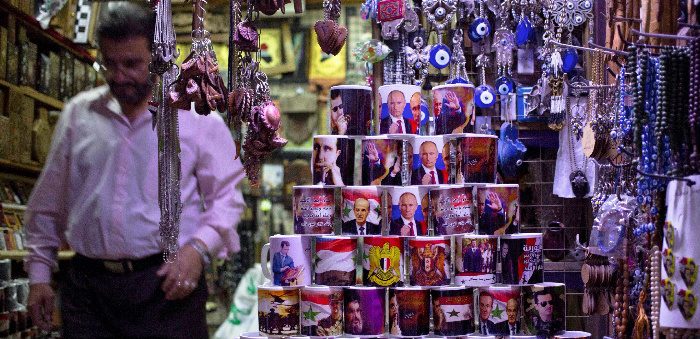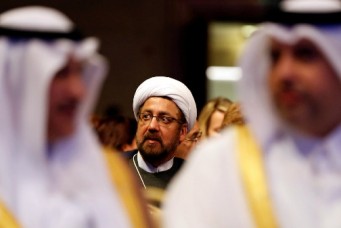Sectarianism and the New Shiism
The roots of religious hatred between Sunni and Shia are political and, surprisingly, recent.

A souvenir shop in old Damascus, April 16, 2016. Hassan Ammar/AP
Civil wars in Yemen, Syria, and Iraq have largely reinforced the perception of an intractable Sunni-Shia conflict. In this outlook, religious heritage becomes the singular lens through which political identity and strife in the region are interpreted. The sectarian framework has been reinforced at all levels of discourse in the United States, including by President Barack Obama, who in his 2016 State of the Union address described the current tensions as an ongoing conflict that has supposedly existed almost since the beginning of Islamic history.
This framework for understanding conflict in the Middle East is convenient, but it ignores much of historical reality. Until the fall of Saddam Hussein’s regime, Sunnis and Shia coexisted relatively peacefully and occasionally even intermarried in countries like Iraq and Lebanon. As a variety of analysts have pointed out, it is primarily current political events, rather than “ancient hatreds,” that have incited upswings in polarization and sectarian conflicts in the region.
The foundational moment for the current regional situation was the Islamic revolution of 1979 in Iran, in which an initially broad coalition rallied behind the Shia religious leader Ayatollah Ruhollah Khomeini to overthrow the repressive and Western-supported Pahlavi dynasty. The rise of a populist Shia regime in Iran incited concerns throughout the region. In Saudi Arabia, the Sunni ruling family and the Wahhabi establishment feared that revolutionary fervor might encourage their own Shia minority to rebel, or spread into a regional conflagration. These fears appeared to be justified, as beginning in 1981 Iranian pilgrims started demonstrating in Mecca during the annual Hajj gathering. The ongoing demonstrations culminated in the 1987 clashes between the pilgrims and Saudi Arabian riot police, leading to at least 400 deaths.
In the years since the establishment of the Islamic Republic in Iran, Tehran and Riyadh have continued to vie for clout and attempted to project their geopolitical influence using not only diplomacy and petro-dollars, but also interpretations of Islam as instruments of foreign policy. The Saudi–Iranian rivalry was significantly exacerbated by the 2003 U.S. invasion of Iraq, which led to the rise of a Shia-dominated regime in Baghdad.
Over the past decade, this ongoing geopolitical jockeying for influence between the two primary regional powers has led to the politicization of sectarian identities. Religious orientations that were previously considered heterodox or outside of the mainstream—most notably the Alawites in Syria and Zaydis in Yemen—have been folded into the Iranian camp, and for political purposes lumped with Iran and Iraq’s Twelver Shia establishment. Yet these “new” Shia have not received a religious imprimatur from the prominent Shia clerics in Qom or Najaf, nor have they received the blessings of the current supreme leader in Iran, Ayatollah Ali Khamenei. The recognition of such groups as being Shia has mainly come from outside the centers of Shia learning, from the realm of politics rather than religious teaching. Many Arab leaders and pundits, as well as Western journalists, have encouraged this reductive categorization for partisan reasons, or perhaps simply as a means to streamline the complexities of the region.
In 2004, King Abdullah II of Jordan coined the term “Shia crescent,” which was soon picked up by then Egyptian President Hosni Mubarak, and repeated by journalists, pundits, and politicians across the globe. The Shia crescent was a supposed sphere of Iranian influence that had grown after the U.S. invasion of Iraq. It extended from Tehran through Baghdad, into President Bashar Al-Assad’s Syria, and from there into Lebanon. The inclusion of Iraq and Lebanon in the purported sphere of Iranian religious influence makes a certain amount of sense, because these countries have large populations of Twelver Shia Muslims, who since the Islamic revolution have come to affirm the authority of spiritual leaders located in Iran. The inclusion of Syria in “the Shia crescent,” however, could only be explained in terms of geopolitics, as Syria is a majority Sunni population whose ruling Alawite family is a close ally of Iran.
Syria and the Alawites
The Alawites are a heterodox Muslim group who split off more than a millennium ago from what is now considered to be mainstream (Twelver) Shiism. Alawite theology is an amalgam of Neoplatonic, Gnostic, Christian, Muslim, and Zoroastrian elements. It proclaims the divinity of Ali, the Prophet Mohammed’s cousin and son-in-law. For most of their existence, the Alawites have been considered a heretic sect by both Sunnis and Shia. It is only since the 1970s that the group has begun to achieve a degree of recognition by certain Shia clerics, most notably Musa Al-Sadr of Lebanon and Hassan Al-Shirazi of Iraq. This recognition was a purely political move by certain leaders who wanted to build a populist coalition and obtain patronage from the Alawite Syrian regime. Al-Sadr and Al-Shirazi are considered minor religious scholars and do not represent the religious leadership in the Najaf and Qom seminaries who comprise the core of Shia religious thought. To the current day, the majority of Shia clerics do not accept the Syrian regime’s bid to remove the stain of heresy from the Alawite creed, and thereby become more acceptable in Syria and the Arab World at large.
The broader political situation, however, is somewhat different. At the start of the Iran-Iraq War in 1980, Syrian ruler Hafez Al-Assad sided with Iran. The reasons behind his choice are rather complex, but the enmity between the two branches of the Baath party, one ruling in Syria and the other ruling in Iraq, was probably the most important factor. Al-Assad’s support for Iran was the beginning of a long and ongoing alliance between the two countries. Iran responded to Syrian support by helping to legitimize the Al-Assad regime and encouraging cultural rapprochement, including the promotion of tourism to Syria. Khomeini’s government funded the construction of a significant new mosque-mausoleum complex at the shrine of Sayyida Zaynab in Damascus, a site that is frequented not only by Twelver Shia but also by Syria’s larger Alawite community.
In more recent years, the involvement of the Iranian Revolutionary Guard in the Syrian civil war, along with the help of its Lebanese proxy Hezbollah and of Iraqi Shia militias, has further consolidated this alliance. Today, the Syrian civil war is widely perceived as being a Sunni-Shia conflict, with Syrian Alawites merely acting as a subset of the Shia community. Yet the rhetoric of sectarian unity among different Shia sects and religious communities is chiefly a function of the Iranian-Syrian alliance, which projects Iranian power at the regional level and keeps open weapons-and-cash transit routes from Tehran to Hezbollah in Beirut.
Yemen and the Houthis
In Yemen, an insurgent group called Ansar Allah (Partisans of God)—popularly known as the Houthis—has been engaged in an intermittent civil war with the country’s government since 2004. The conflict culminated in a take-over of the Yemeni capital in January of 2015, which in turn triggered a full-fledged, Saudi-led intervention on behalf of the struggling regime. The Houthis are part of a revival of Zaydism, an Islamic sect that ruled independently in Yemen for nearly a thousand years prior to the overthrow of the imamate in the 1960s. Sometimes called “Fiver Shia” (because they recognize only the first five Imams instead of the full twelve), the Zaydis by extrapolation do not accept the Wali Al-Faqih (Guardianship of the Jurist) as developed by Ayatollah Khomeini in Iran. Twelver Shia have never considered the Houthis as an authentic part of the Shia religious fold.
However, that is not how Saudi Arabia and other Gulf states have understood the Houthi rebellion. As the Yemeni conflict escalated and the Saudi-supported regime of President Abdu Rabbu Mansour Hadi threatened to crumble, the insurgency was increasingly painted by Saudi Arabia as an extension of Iranian influence. For many political leaders and international commentators, the civil war in Yemen became another paradigmatic example of Sunni-Shia conflict, with the particularities of the Zaydi religion erased and sectarianism standing in place of broader geopolitical tensions. The Saudi regime has even claimed that Iranian advisors and Hezbollah operatives are involved in Yemen, training the Houthis in guerilla warfare and helping them carry out operations.
The affinity between the Houthi rebels and the Iranian regime may have some basis in reality, as the group’s founding ideology is quite sympathetic to Khomeini’s revolutionary agenda. However, it would be wrong to overstate Iran’s interest in Yemen, and particularly, to characterize this interest strictly as a sectarian religious affiliation, rather than the more complex nexus of ideology and geopolitical aspiration that it actually is. By characterizing the Zaydis as Shia, commentators again substitute simplistic sectarian demarcations for the reality of multi-faceted political conflicts.
A New Cold War
Alongside the Arab uprisings and various international interventions of the past few decades, the “new Arab cold war” between Saudi Arabia and Iran is the primary engine of sectarianism in the region, as each of these rivals seeks to project its influence. The tensions fanned in this cold war have created a new category of Shia—groups that do not actually follow the tenets of mainstream Twelver Shiism, but for all practical purposes have come to be regarded as Shia due to their geopolitical positioning. This new category is not an accurate religious classification, but is rather a way of reducing complex theological and political differences into easy-to-digest buzzwords and sound bites.
Rola El-Husseini is research associate professor at the Middle East and Middle Eastern American Center, City University of New York (CUNY). She is the author of Pax Syriana: Elite Politics in Postwar Lebanon. On Twitter: @rola_husseini.


